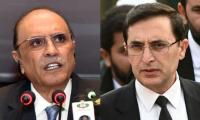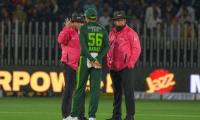Though this is a very slippery track to venture on, there is some truth in the adage: ‘stats don’t lie’. But this is only a mathematical journey that I delve in, and nothing else. Politics is fickle, yet will qualify estimates. So if it all goes wrong, please don’t blame me.
But if this little exercise in numbers and in reading tea leaves to establish future contours can help political parties understand the environment better and face up to possible realities, however unsavoury, it can only help them focus on their shortcomings.
There is one other factor: black-swan events; the once in a blue moon happening which can entirely sway the predictions to what can be beyond imagination. Like Imran Khan’s political tsunami which was proclaimed but did not happen; or a Zulfikar Ali Bhutto like phenomenon, which materialised and has since become a measure of sorts. Such events too need grounds to be prepared for them to take root and then grow disproportionate to expectations. What is even more critical is to keep the momentum going for it to become a sweeping wave, or a tsunami if you please. Can Nawaz Sharif be that person in 2018 who can trigger a sentiment of sympathy? Has he ever been that person since he began politics in the 1980s? He hasn’t, yet he could be; with a critical difference: ZAB swept through over all of Pakistan; Nawaz might do it in Punjab only.
With even more challenges on the way in the courts, Nawaz Sharif can be personally and politically injured beyond recovery. So could be Maryam, at least for this time. The time between court verdicts and the force of their impact among the electorate may not be enough to create conditions for a tsunami of sympathy. Yet, were the convictions to lead to incarceration of any kind that could unleash instant reaction in Punjab, overriding any other consideration. Can IK create a tsunami of his own? That is still very much an IK remit, though he has mostly been missing from the scene in the last six months hoping the courts might turn him into a default victor. In the remaining 100 plus days before the 2018 Elections, he just might find it difficult to shape one. Except for a black-swan, the two will have to thus slug it out.
On to the electoral train. With the NA seats disproportionately divided between Punjab (148) and the rest of the country (124), it has always meant that whoever won Punjab would win nationally. The numbers have only been slightly adjusted for the 2018 elections in response to the fresh census, yet leaving Punjab with a lion’s share (139). The PML-N duly won 81 percent of the contested seats in Punjab in 2013. The PTI and the PPP carried only 4 and 2 percent of that number. That told the complete story of Election 2013. The independents were the other significant number and, as is their wont they join the winner, and bloated the PML-N’s winning margin to the almost magical two-thirds mark. Let this be the base of further inquest.
There are two additional considerations to see when the PML-N estimates prospects in 2018. One is the extent of injury to Nawaz Sharif as a consequence of the ongoing legal cases against him and his family, where time-based – if not perpetual – disqualification looms. Second, arising out of this may be the sense of an absent hierarchical delineation, which might mean loss of focus and unease in the ranks leading to partial fragmentation. Third, an existential sense that Nawaz Sharif erred is bound to reside in some minds especially in the more informed towns of Punjab. This will entail a political cost.
It is likely thus, despite Lodhran – where the PML-N swept the by-election against predictions in an exemplary electoral victory against a PTI stalwart and his progeny – that the PML-N may suffer about 15-20 percent loss in its electoral standing in Punjab. It could have been far greater but MNS and Co have played their game well and have limited the damage considerably. This will mean a deficit of around 25 seats from their 2013 number. Given that their organisation is well entrenched at the constituency level, and they continue to do exceedingly well in practically all by-elections, and their jalsas remain lively and vibrant with impressive numbers, and that the future interim governments will carry their significant say in formulation, the PML-N still seems to be well placed in Punjab and its tally of seats in the 2018 elections there could be around 95. Except for a black-swan.
The PML-N ceded space politically, even in Punjab, and it remains for others to occupy that space. The PTI has wavered in its political focus and lost its momentum. It may have assumed success too early without realising that space vacated still needs to be occupied as a consequence of steps like constituency work and on-ground focus in sounding out likely ticket-holders. This has all been absent. Yet some gains will be made by it over what it achieved in 2013 (6 NA directly contested seats) via the impressive role of IK in bringing the strongman of Punjab, MNS, to this pass. Say the gain is around 15 percent – for lack of not doing what was needed sufficiently to benefit. That translates to around 20 additional seats. It’s likely tally in Punjab then is raised to around 25 NA seats. This is not a number on which parties win nationally. Independents come later after the national situation of the polls is far clearer.
The remaining 5 percent must go to the PPP, given that it has begun to show itself more there and southern Punjab is likely to warm up to it despite its abysmal showing in the Lodhran by-poll. Give it to the smart Asif Zardari and his manipulations of the political scene which may grant the PPP some 6-7 seats in Punjab bringing the tally to around 10. Around the same number of independents will either get divided or go with the flow of the majority. With only a partial increase of seats for the two challengers in Punjab, it will be the PML-N which is most likely to retain its electoral strength as in 2013.
Add to it seats from the rest of the country and it makes for an interesting set of options. In 2013, the PML-N got only 10 directly contested NA seats from the rest of the country. They are unlikely to breach the PPP’s stronghold in Sindh and may have already suffered at Zardari’s hand in Balochistan. Sindh and Balochistan may not deliver much. That will leave KP where it is likely to improve its tally beyond the 5 it won in 2013. Another 3 and a couple of independents will mean around 10 NA seats from KP for the PML-N. That puts the total tally at around 105-110 NA seats of the 272 directly contested for PML-N in the 2018 elections; short of a simple majority. The PTI and the PPP aren’t any better off by these estimates.
By such count, the PPP performing better than 2013 in Sindh, Balochistan, KP and Punjab could garner a total of some 60 seats. Similarly, if the PTI can hold onto its numbers in KP its tally may improve closer to 50 nationally. The PTI not joining up with the PPP can only mean that it shall have to sit out next time too. The PML-N could then join with the PPP or smaller partners from all over to make the simple majority to form the next government. Lest you tear me apart, this is only an estimate – black-swan excepting. And remember stats don’t lie.
Email: shhzdchdhry@yahoo.com
A woman walks past a building of the International Monetary Fund. — AFP/FileThe annual and spring meetings of the...
Late Benazir Bhutto's daughter Asifa Bhutto Zardari addresses the Christian community in Bihar Colony on January 23,...
Representational image. — PexelsWater is an important scarce natural resource that is required for several everyday...
Pakistani employees of online marketplace company Kaymu at work in Karachi. — AFP/FileThe true spirit of development...
India uses Afghanistan as a backstage area to carry out terrorist attacks against Pakistan
Another report by the Pakistan Institute of Peace Studies states that 78 per cent of attacks have been carried out by...







